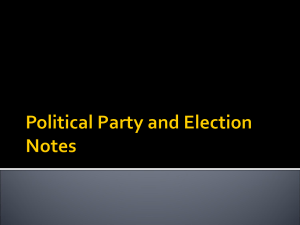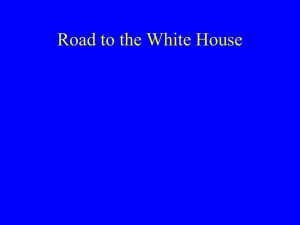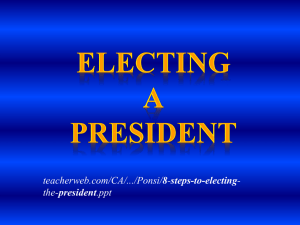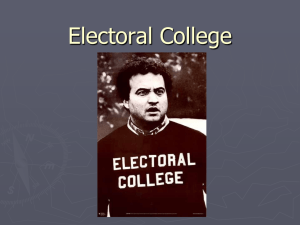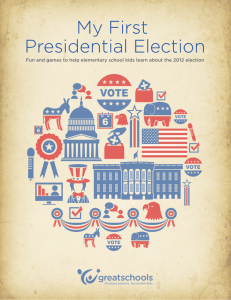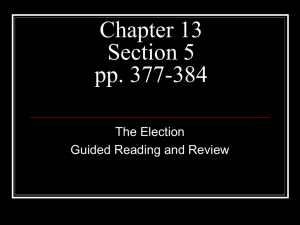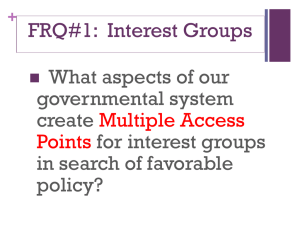Campaigns & Elections - Glenbard North High School
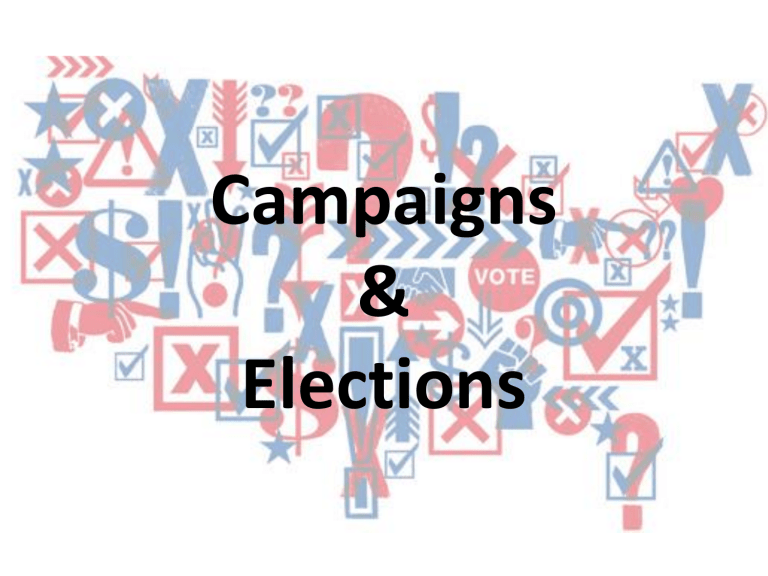
Campaigns
&
Elections
Preview
Put the following steps in order in your notebook. Star any terms you do not understand.
• Form a campaign organization
• Run in primaries & caucuses
• Participate in televised debates
• Announce candidacy
• Conduct electoral vote
• Attend national convention
• Raise funds
• Hold popular vote
• Build coalition of supporters
• Develop campaign strategy
Types of Elections
Primary Election
An election in which voters determine their party’s nominee for an elective office
General Election
An election in which voters choose among candidates from different parties to fill an elective office
Special Election
An election in which voters choose someone to fill an unexpected vacancy of a House or Senate seat
Primary Elections
Primary Election Calendar, 2008
Homework: Ch. 10.3
Begin reading at “Joining the Race,” and work with a partner to create a “to-do” list chart for a presidential candidate trying to secure his/her party’s nomination. See the model below.
• Form exploratory committee
• Join the race
• Set up campaign organization
• Raise funds
• Develop campaign strategy
• Campaign
• Run in primaries and caucuses
• Attend national convention
Town Hall Meeting
General Elections
The “Winner-Take-All” System
(The candidate with the most votes wins.)
Reinforces two-party system
(Democrat vs. Republican)
What about third parties?
Third Parties’ Impact
• Focus on a single issue
• Bring new ideas to the political discussion
• Take votes away from major parties
Presidential Elections
The Electoral College
• Method by which we elect the president
• Each state has a certain number of electors =
# of Senators (2) + # of Representatives
• Candidate who wins the majority of the state’s popular vote gets ALL of that state’s electoral votes
• Candidate must achieve a majority of the electoral college (270/538 votes) to win
Presidential Election Results, 2008
(By County)
Preview
Homework: Ch. 10.4
Read Ch. 10.4 up to “Issues Versus Image”
• Define presidential & midterm elections.
• Explain how John Kerry’s 2004 campaign illustrates the typical candidate’s change in strategy from the primary to the general election.
• Explain the effects of our country’s “winnertake-all” system.
The Election of 2000
Popular Vote
Electoral Vote
George W. Bush (R) Al Gore (D)
50,456,062 50,996,582
271 266
And the winner is…
What happened???
The Electoral College Map, 2000
It all came down to Florida.
The Sequence of Events
• 6 million people vote
• Computer count: 327 vote margin for Bush
• Gore demands recount by hand
• Florida Secretary of State sets deadline
• Florida Supreme Court extends deadline
• U.S. Supreme Court halts recount
• Result of recount: 537 vote margin for Bush
• Bush wins ALL of Florida’s 25 electoral votes
Green Party Candidate: Ralph Nader
97,488 votes in Florida
Conspiracy Theories
How can this happen?
• Candidate can win by large margin in popular vote, but only needs 50% + 1.
• Small states are over-represented in the electoral college
How much does your vote count?
Problems with Electoral College
• Candidates focus only on “swing states,” so people are left out of the process.
• Our votes are not actually equal!
• More popular candidate nationally can lose the election!
“Battleground” or “Swing” States
Interest Groups &
Lobbying
What is an interest group?
• A group that seeks to influence government to reach a particular goal or set of goals
• Examples
What do interest groups do?
• Lobby – Attempt to influence policy process by persuading public officials to favor or oppose action on a specific issue
• Research – Carry out research and write policy proposals that support their goals
• Litigation – Bring lawsuits to influence policy
(e.g. NAACP & Brown v. Board of Education)
• Grassroots Mobilization – Hold rallies, conduct direct mail/Internet campaigns, etc.
What is the artist’s point of view regarding the role of interest groups?
Campaign Finance
High Cost of Running for Office
• 2000: More than $3 billion spent on election campaigns
• Winning candidates spent…
– $500,000 each for House of Representatives
– $4.5 million each for Senate
Library Activity: Interactive Map
Political Action Committee
• Private groups sponsored by corporations, trade associations, unions, or other interest groups
• Allowed to collect donations & give money to political campaigns
• How much do they contribute?
– 1980: $131 million
– 2004: $310 million
Types of Organizations that Form PACS
Campaign Contribution Limits
Primary
Election
General
Election
Individual Limit
$2400
$2400
PAC Limit
$5000
$5000
Loopholes in Campaign Finance Laws
• 527 Organizations – Non-profit organizations with no limits on spending (“soft money”) for voter registration & turnout activities
• Issue Ads – Political ads funded and produced by interest groups
– Cannot explicitly tell people to vote for a certain candidate.
Corporate Contributions
Issue Ad Example
Issue Ad Example
527 Ad
What is the artist’s point of view regarding campaign finance?
Chalk Talk, Part I
• Where do we get information about government & politics?
• How much control do political candidates have over this information?
Campaign Advertisement Analysis
• 1968: Nixon (R) vs. Humphrey (D)
• Chalk Talk, Part II: What are some images you associate with “war” and “peace”?
“Convention” “Mother and Child” vs.
Campaign Advertisement Analysis
Discussion Questions
• What images did you see? (Be descriptive!)
• Why do you think the ad uses these images?
• Does anything you see remind you of the images you associated with "war" or "peace" in the brainstorming activity? Why or why not?
• What feeling(s) do you get from these images? Why
• How are the images put together? Does the ad put images of different people, places, or events next to each other? If so, what effect does that have?
• Is the ad in color or black-and-white? What effect does that have?
• What do you think the ad is about? Why?
Campaign Advertisement Analysis
Discussion Questions
• What was the ad about?
• What music did you hear? Describe it.
• Was there a voice-over? If so, what words or phrases did you hear?
• How was the voice-over of the ad similar to or different from what you expected?
• How did the music and/or voice-over complement the images?
• What is the relationship between the ad’s images, soundtrack, and subject matter?
• What did you learn about the candidate?
• How important are the sounds and images in making the ad persuasive?
Final Discussion Questions
• Which ad do you find more aesthetically appealing? Why?
• Which ad do you find more persuasive? Why?
• What do you think is more important – images or sound – in creating an effective campaign ad?


